|
|
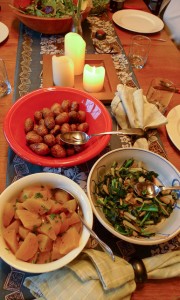 Late April localvore spread. “Hey, lets go pick wild leeks and then make a localvore meal.” That welcome invitation from Karen came late last Saturday morning and by evening we had assembled  a magnificent feast. The last-minute dinner party was particularly notable for how easy it was to load the table with a wide range of delicious local products– foraged, harvested from the garden, and bought at nearby markets and farm stands.
Just a few years ago, assembling such a meal would have required a significant effort but thanks to the “local foods movement” and the committed businesses creating excellent products for the growing market of discriminating eaters, it no long requires a major undertaking and certainly no sacrifices in quality and deliciousness. What struck me too were all the interconnected relationships we had with the food and stories behind each item. Here’s a sampling.
 Morel appetizer– Eric sauted our just-picked morels and wild leeks  in butter with a white wine reduction and touch of cream. Served on toasted Mad River Grain bread from Red Hen Bakery.
Fiddleheads – Karen had picked a pile of them the day before because the ostrich ferns were unfurling fast in the warm temperatures. Served simply steamed so they had that crunchy, unique texture that makes them so fun to eat. Â
Potatoes – whole baby German Butterball potatoes from Jericho Settlers Farm, roasted in the grill.  They might have been the most delicious potatoes I’ve ever tasted! I stopped by the farm the next day, anxious to pick up some more and ran into Christa, the farmer, who said the potatoes had been harvested back in October and stored in a refrigerator at around 40 degrees. That kept them in almost perfect condition all the way to the end of April.  Â
Green salad – Kath brought a multi-textured assortment of overwintered greens from her unheated greenhouse, applying the season extending methods discussed in previous posts — but with greater success than me! We threw in some lightly steamed asparagus from my hoop house and dressed the salad with a quick dressing made from last year’s shallots, sunflower oil from the Rainville Farm and red wine vinegar that we’d “made” just by letting old wine sit in a jar for several months.Â
Golden beets – picked last fall, Kath stored them in bags at the back of her refridgerator over the winter and for this meal, paraboiled, slipped the skins and dressed them with a little butter and fresh chives.  The smooth texture and sweet-rich flavor complimented all the other foods.  She noted that the variety, Touchstone Gold, germinates better than other golden beets — a tip I will aim to remember for next year’s seed order.Â
Flat iron steak– Greg grilled grass fed beef from the rich Lamoille River valley at Boyden Farms just a few miles north of here.  It was cooked to perfection and served with it minimal seasoning, featuring the full, natural flavor of the meat.Â
Wild leeks – just picked within the hour, sauteed, cooking the white bulb first until it is tender and then adding the green leafy parts at the end. Such a refined flavor for a wild plant – somewhere between onions and garlic.Â
For beverages we had Kath’s home-made grape juice from wild vines that grow near her home in Richmond and a crisp seyval blanc from the the Boyden Valley vineyard, adjacent to the farm where the beef was raised, that paired particularly well with the spring fare. Finally for dessert, Karen’s blueberry sauce made from berries picked and frozen last summer with home made ice cream.Â
Oh, I forgot to even mention the assortment of wonderful local cheeses — but that will have to wait for another post.
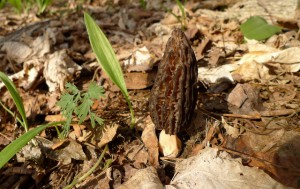 The elusive black morel. Finding morels, the first gourmet wild mushroom of the season, offers a thrill above all others. As maddeningly elusive as they are delicious, they’ve been a bit of an obsession of mine for the past decade. Despite my enthusiasm and frequent forays in search of them, each spring passed, disappointingly with no morels.
That is, until last spring. Scrambling up a steep slope dominated by mature ash trees on a wild leek foray with Karen and Greg, we stumbled onto morels in perfect condition, popping up through the leaf litter and moss. What a thrill to find them in real life, not just in pictures! Those lovely little mushrooms, used deliciously and judiciously, as well as dried for storage, graced many a meal over the past year.
So this past weekend, not daring to hope for success again, we ventured out to the same hallowed ground, ostensibly to harvest the abundant wild leeks. And there they were, perfect little morels, just as we found them last year. What can you do but give a little whoop and and dance amongst the spring ephemerals? We picked enough to make a savory appetizer for our localvore dinner and divided the rest between our two households — enough for bragging rights but not so much to quench the desire to seek more.
Before leaving that blessed place so favored by morels, I took a long, analytic look, hoping to absorb the features. At every subseqent opportunity I’ve searched and found other places that look much the same — rich soils inhabited by wild leeks and trilium, large ash trees with little intrusion from maples, a slope with some erosion and moss — but with no sign of morels.
Â
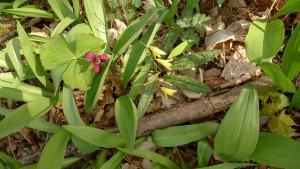 Wild leeks, trilium and trout lilies - the forest ephemerals of spring Hunting morels seems to require about 75% luck and 25% knowledge. Mushrooms in general, and morels in particular are peculiar creatures. The primary organism is a network of filaments underground for morels and in wood for oyster mushrooms and others of thier ilk. What we see on the surface as a mushroom, is the ingenious fruiting body, designed to deliver spores into the air. The underground portion can grow for years without fruiting if conditions don’t suit it. So even with close attention to terrain, vegetation, weather, moisture, soil type and acidity, temperature, and timing it’s tough to predict where morels might happen to live and when they might decide to fruit.
 But the hunt itself is good healthy fun so why not continue. Maybe I’ll get lucky this year and actually find some yellow morels. They are said fruit later, when the apple trees bloom and the oak leaves are the size of a mouse’s ear. That charming description itself, motivates me want to look for them, despite my utter lack of sucess to date.Â
 As with all foraging, be sure to consult a reliable expert or resource book before eating any wild mushroom and always cook them well. A number of websites offer advice and good photos of both the edible morels and the look-alikes you should admire but not eat.
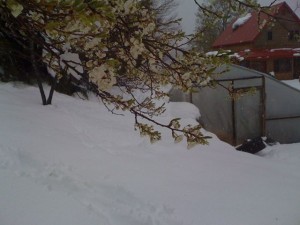 Plum blossoms after snow stom Wet, gloppy snow started falling yesterday morning and continued through most of today. Electrical power has been out for 36 hours due to trees and branches falling on power lines. Since we have a wood stove for heat, the biggest inconvenience has been lack of water.
So strangely beautiful to see the green haze of early-leafing trees through the falling snow. It never went much below freezing so I’m not concerned about cold damage to the leaves but a lot of fruit trees had just begun to bloom so we’ll see if the blossoms remain viable.
The photo shows one of my plum trees after the storm, blooming too soon for it’s own good.
This is an experiment to try posting directly from my iPhone, in the dark!
 Salad of mixed greens from hoop house Fresh harvests of salad greens, herbs, scallions and even a few spears of asparagus have increasingly supplied our table from the unheated hoop house over the past few weeks. Spinach and lettuces planted in February and March now pump out new leaves for regular picking. Despite bolting early, the overwintered arugula and mache have still been tender enough to harvest repeatedly.Â
Daylight hours now compare in length to late August, offering the plants more light every day.  As the plants form larger leaves, they collect even more solar energy so growth takes off exponentially. If you haven’t planted any of the cool weather crops yet, don’t wait. Get them in the ground now to take advantage of the long days and good growing conditions.Â
By now, you won’t need a hoop house or other plant protection gear to harvest from the garden. The hardiest perennial herbs and vegetables have now emerged — chives, lovage, sage, oregano, mint, multiplying onions — with new growth full of fresh flavor.  If you managed to protect and overwinter the cold tolerant annual and biennial herbs like parsley, cilantro and chervil, their fresh new leaves make for good nibbling right in the garden and at the table, if you can get them there!   Â
Then come the real treats of the season — the wild spring harvests. Wild leeks (ramps) top my list of favorites. Their relatively long harvest period overlaps with fiddleheads and the elusive morels that are not quite ready around here yet, but coming soon. As with all woodland edibles, take care not to over-harvest.  A little here, a little there and a lot left behind.  In clearings you can find dandelion greens and the small leaves and flowers of violets that add nice color and flavor to salads. If you’re unsure of what these plants look like, here’s a foraging site that can help.Â
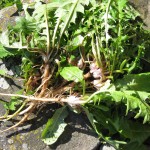 Dandelions ready to cook Nan would look out at the bright dandelions in the pasture near her home and remember fondly how her mother and grandmother would fill their aprons with the greens in spring.  She spoke longingly of the how delicious they were, simmered in a big pot for hours, seasoned with salt pork. I knew Nan in her late eighties when she could no longer traverse the uneven ground outside to pick them herself, but the greens still called to her.
Dandelions inspire in me, the same urge to consume. Any time I spot the distinctively jagged rosette of leaves, among the first to to emerge and growing so strongly, I want to dig and eat them. It’s as though the body craves the plant’s strength — the bitterness of the leaves, the slightly sweet complexity of the roots and all the beneficial minerals and vitamins that those deep flavors suggest. I prefer a light saute of dandelion leaves with browned onions, garlic and chili flakes to the old fashioned method of cooking the leaves to death, but there is a theory that thorough cooking is necessary to break down the cells in the leaves to make the minerals available. (Also a theory that the roots should not be over-cooked.) Whatever your approach, once you’ve developed a taste for dandelions, your spring won’t be complete without eating them. Â
Europeans brought dandelions to the New World along with so many other medicinal and culinary herbs that have spread and become so common that our culture now considers them noxious weeds. But herbal traditions in both the East and the West regard dandelions highly, especially as a liver tonic. This concept of a tonic – a medicine that is useful, not for any specific disease or symptom but as a general enhancement to health — has been lost in the modern medical regime.  Herbal texts often refer to dandelion’s ability to relieve “liver congestion,” especially after a long winter of eating heavy foods.  I’m not sure what liver congestion means but it sure sounds like something I want to avoid!
Among many other therapeutic uses, dandelion leaves are said to to reduce high blood pressure and the roots have been used to treat anemia, diabetes and to build strength after illness. Rosemary Gladstar noted that the medicines we need to treat our most common, everyday health concerns are found in the commonest plants growing all around us. So often the ones we work so hard to eradicate.
Dandelions also have a tonic effect in the garden. The deep roots break up compacted soil and take up minerals that can be made available to garden plants.  During the warmer months when dandelions are too bitter for eating, I’ll add them to my compost (removing the flowers first) or lay them on top of mulch.  When weeding, if I come across a particularly handsome dandelion with large glossy leaves and a thick root, I’ll let it be so it can seed itself to improve the genetic strains of dandelion on my property.  A big, juicy dandelion can be a far more valuable crop that those I planted deliberately in the garden.
If you’ve haven’t developed a taste and craving for bitter flavors in spring, try dandelion greens cooked with starchy foods like risotto, pasta dishes or potatoes.  They take the edge off the bitterness.  A quick Google search will yield lots of yummy recipes. And for a dark herbal tea, ground and roasted dandelion roots can’t be beat (although some prefer the roots of another weedy relative, chicory). Always pick dandelions and other wild foods from clean soil, avoiding roadsides and edges of parking lots.  Then savor the free food and medicine, compliments of Mother Nature.
 Newest generation of foragers - Brynna with wild leeks Since late November until just last week, walks in the woods and fields have been a little dull. Animal tracking can keep the brain cells active on winter walks, but for us non-hunters and foragers, the flush of green on the forest floor stimulates a powerful and primitive excitement — an urge to ramble, smell, taste and consume the nutrition offered by the earth. Â
From the pungent taste of the first blade of wild leeks pointing up out of the ground to the sweet pithiness of the last wizened apple, anticipation of the months ahead is marked by the progression of foods to be found on our home ground. Similarly, my mental map of the the surrounding landscape marks the places I know to find nettles, chanterelles and the best blackberries. This focus on food might be considered obsessive but I choose instead to consider it a gift from my ancestors – those from millions of pre-agricultural (and pre-human) generations who populated this planet, eating the landscape.Â
Research I read about some time ago, found women tend to navigate the landscape with a mental map of static reference points – the giant pine with a split in the trunk, the sunlit clearing with raspberries.  Men on the other hand, tend to hold a more abstract sense of space, enabling navigation while focused on a moving object. This of course would support the theory that women are more disposed to foraging and men to hunting. I don’t like to over-generalize about gender differences, since each individual has different mix of these capabilities and I believe most skills can be learned.Â
But when I examine my way of navigating this landscape, I do indeed rely on a mental map with stored images of fixed objects. More often than not, those objects are related to places I have found food.
 Boiling last of the maple sap on an 80 degree day, drinking maple mojitos and listening to Bachata tunes.  Red maple blossoms and golden stems of willow, wash the hillsides with a faint echo of fall colors.  Hoop house ignites with green growth. 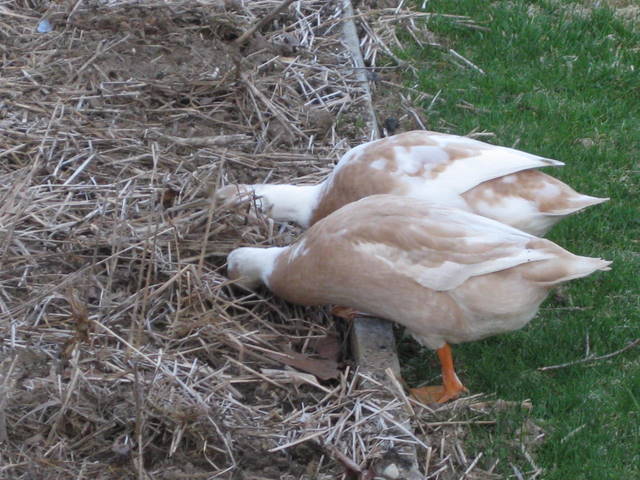 Duckies snarfling for slimy goodies in the garden.
In the great, northeastern tomato die-off of 2009, when late blight, riding the cool, moisture-laden air of an exceptionally rainy summer, infected nearly every tomato plant in the region, two tomato varieties emerged as my heroes, enabling us to eat fresh tomatoes until Thanksgiving and even preserve some. Juliet, the blight-resistant “sweet plum cluster” tomato that has long been a favorite of mine, not surprisingly, was a winner. Cosmonaut Volkov, a newcomer, lived up to his lofty name, pumping out loads of big, round juicy tomatoes that even picked green, ripened beautifully over the season.
Here’s my story of how the worst effects of blight were forestalled last year.  In July, hysteria about the spread of late blight grew steadily as reports of infected farms and gardens rippled through the media and water cooler conversations.  A few days before I went away in early August, a neighbor’s tomatoes plants began to show watery, black spots on the leaves — the sign that the blight had arrived.  During my week away, I checked in for regular updates from home and researched the options for managing the inevitable blight infection. Sure enough, I found black spots on the plants upon returning.Â
In blast of resolve that could only be explained by my fretting from afar, I picked all the fruit, ripped out all the plants and seeded the beds with a cover crop. All the tomatoes — green, red and in-between – were placed in shallow trays and baskets, and stored in an airy place. The tomato plants and any affected fruit were tossed in the woods where they could feed the soil and where winter temperatures would destroy the disease organisms. All tomato parts (including the cousins – peppers, eggplants and tomatillos) were kept out of the compost pile where the disease might winter over and I was careful not to dig up the potatoes for storage until the foliage had been killed by frost.
Did I over-react? I don’t know.  Others prolonged the agony by removing blighted leaves and trying to keep their plants going for as long as possible. All through August and September I second guesed my decision to destroy the plants. But as the months went by and the green tomatoes kept ripening nicely in storage, my confidence in the drastic approach grew.  Â
Like all the other tomato varieties, both Julie and Cosmo were affected by blight but still produced a high volume of fruit, not only because of their slight advantage in resisting disease and their habit of producing well in less than optimal weather but also because they tend to set fruit in clusters.  We had enough ripe Juliets in late summer to make over a quart of dried tomatoes that have lasted through the winter.  I highly recommend both these varieties for Zone 4 gardeners, especially where summers are cool.
 Duck egg laid between two bales of straw. A month or two ago, feathers began to accumulate in the straw and leaf bedding, deposited by our two duckies who winter in the hoop house. That signalled the start of their spring molt and the promise of eggs. But first they needed to grow out their feather wardrobe for new fashion season.  Only when they achieved that miraculous feat, could their little bodies  begin the even more miraculous task of creating eggs.Â
And this morning, at long last, I found the first egg of the season!  It is as much a sign of spring as any green plant. We love our duck eggs. Rich, large-yolked, firm and flavorful, they make great omelets, frittatas and are perfect for baking.  For a weekend brunch we like to bake duck eggs in ramekins. At the the bottom of each ramekin put a few tablespoons of sauteed leeks and mushrooms (great use of reconstituted wild mushrooms) and break an egg over top. Once baked to taste, between the oven and table, we add a touch of fragrant truffle oil. Yum!Â
 Daisy and Violet (Indian Runners) in their winter quarters. People often ask why we raise ducks rather than the more common practice of raising chickens. The short answer: I just love duckies for their intrinsic goofiness. The long answer: they do a great job of converting the readily available protein of slugs and grubs into eggs that we humans can better enjoy. They’re also easy to raise. The main husbandry concern, as with chickens, is providing housing that protects them from predators. Â
Every predator in the forest salivates for bit of duck fat and over the years we’ve lost too many of our little friends to foxes, raccoons and possibly even to hawks. Ducks don’t need to have a pond but we normally put out a kiddy pool or other low-rimmed containers for them to splash and play in. The resulting nutrient-rich “duck water” can be used for fertilizing the garden (avoiding any plants that will be eaten raw).
Our ducks free-range when we’re at home. They can fly if necessary but normally stay within the bounds of our clearing.  Since they are encouraged to forage for slugs in the garden, we must erect 12-18″ fences around any beds with tender seedlings and those with lettuce or other tasty greens. Ducks will demolish most salad greens if given a chance. Indian Runners and Khaki Campbells that are bred for egg laying and not for meat, are the best foragers. They lay eggs almost daily from spring until late fall (usually with 4-6 weeks off for a summer molt) and are ravenous for slugs, worms and insects when producing eggs.Â
In winter they don’t do much but have no trouble surviving even the coldest nights with nothing more than protection from wind and some dry bedding. Funny, hardy and useful. What more could you want from a fellow creature?
Yesterday, the warm air inspired me to prune the grape vines and other fruiting vines and trees. While a very pleasant task, pruning these trees and vines always always makes me reflect on my inadequacies as a gardener.
My failures include the 10 year old grape vines that didn’t bother to produce at all last year and only grudingly before, and the 17 year old pear trees that have yet to even to form a fruiting bud. Same with the columnar apple trees received as gifts 10 years ago. And then there are the plum and sour cherry trees that do OK but just barely. Each year I try to do things differently — adjust the soil, prune less or more – but there’s only once chance to get it right each year. And as the years go by without little or no improvement, it does get discouraging. Sigh.
Thomas Jefferson’s famous quote made late in his life, offers a bit of a consolation. Â
“No occupation is so delightful to me as the culture of the earth, & no culture comparable to that of the garden. but tho’ an old man, I am but a young gardener.”
 –Thomas Jefferson to Charles Willson Peale, 20 August 1811
For a guy with a bunch of slaves around doing the actual gardening work, many of whom must have been highly competent gardeners, that statement seems rather pretentious. Or maybe Jefferson in his old age truely was a “young gardener” since he spent most of his adult life away from home, his gardening mainly a theoretical exercise conducted from afar.
Regardless of your views on Jefferson, I highly recommend a visit to Monticello at this time of year. Besides seeing his thoughtfully-designed gardens and learning about the life of an 18th Century foodie, I longingly recall the delicate salmon and magenta blossoms of dogwood and redbud drifting like clouds through the understory of the surrounding forests. Sigh again.     Â
Finally, on a somewhat related and cheery note, check out this passionate Rant about why we should be glad to be aging gardeners.  None of this helps with my fruit growing skills, but I do feel better and suffice it to say, I’ll keep trying and when I stumble upon any fruit-related success, you’ll hear about it here.
|
|












